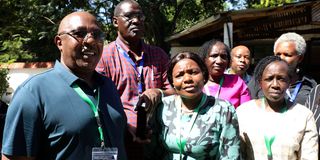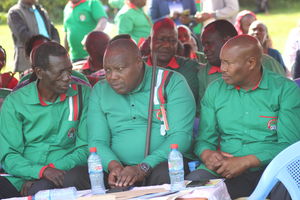
Kenya Secondary Schools Heads Association (KESSHA) National Chairperson Willie Kuria (left) with other officials and head teachers during Muranga Annual Conference in Mombasa on April 9, 2025.
Public schools are operating at the bare minimum level, scaling down some services and activities as the government delay to disburse capitation funds continues, close to a month since the beginning of Term II.
Faced with empty stores, unpaid non-teaching staff and suppliers, school principals have sounded an alarm over a deepening financial crisis. The most affected are day schools attended by more than 70 percent of learners in secondary school and which wholly rely on the Free Day Secondary Education (FDSE) funding.
Principals who spoke to the Nation said that learning programmes have been affected, as well as co-curricular activities. According to Kenya Secondary Schools Heads Association (KESSHA) national chair, Willie Kuria, the government owes schools a balance of Sh2,300 per student from Term one when schools are supposed to receive 50 percent of the annual capitation.
The annual capitation per learner is Sh22,244. The money is only intended for tuition expenses and does not cover meals and other needs.
“There is no money in schools. We have entered the third week and there are difficulties in schools because this is affecting the quality of learning. We are limiting everything and it’s not fair. Day schools, especially, are not able to do anything. They are not able to pay the salaries, conduct have laboratory technical lessons and could not do opener exams because they do not have anything. Some teachers have to buy their own chalk to go to class,” said Mr Kuria.

Kenya Secondary Schools Heads Association (Kessha) boss Willy Kuria addressing the press during the Kessha conference in Mombasa in this photo taken on June 25, 2024
Mr Kuria further revealed that schools, especially in rural and marginalised areas are unable to print or administer tests, forcing learners to idle in classrooms. Some schools have resorted to issuing incomplete papers due to a lack of printing materials.
“There was a pending balance from last term; Sh2,300 per student. We expected the same amount, or more, this term. We’ve been waiting for the government to clear the arrears. We thought the funds would be disbursed before schools reopened to help us jump-start operations, but nothing has come through,” he added.
Awaiting disbursement
The Nation understands that the funds have been released by the National Treasury and are now awaiting disbursement by the Ministry of Education. We also learnt that the Principal Secretary for Basic Education Prof Julius Bitok is currently out of the country, when we sought his comment on the matter.
Mr Kuria noted that the delays in disbursement have also hampered students’ participation in co-curricular activities.
“We are forced to limit participation in co-curricular events, and even when it comes to science practicals, we can’t afford the materials. Everything is affected,” he added.
He said that some learning materials, such as stationery, are now being provided by parents.
“Sometimes the students bring exercise books from home. If the parents are cooperative, they can bring papers, but this is not sustainable,” he said.
According to Mr Kuria, Term II is the longest term of the academic calendar, with many co-curricular activities as well as mock Kenya Certificate of Secondary Education taking place.

Students walk on the streets of Nakuru city.
The national secretary of the Kenya Teachers in Hardship and Arid Areas Welfare Association (KETHAWA), Wangonya Wangenye, said heads of institutions working in hardship areas bear the brunt of delayed capitation. He noted that the situation has become dire, with some regions experiencing prolonged dry seasons and poor harvests, pushing the cost of food to nearly triple market rates.
"In areas such as West Pokot, Kapedo, and Baragoi in Samburu County, food prices are exorbitant due to persistent banditry. A principal informed us that business people ferrying supplies must be escorted by police to access these regions, a cost that is ultimately passed on to the schools. In many cases, principals are digging into their own pockets to cover these expenses," Mr Wangenye said.
He added that insecurity in Marsabit, Isiolo counties, and the larger Northern region has compounded the problem, making it difficult for schools to access even basic tuition materials.
"In these areas, both teachers and students are going without food and there is no learning materials due to lack of funds. Curriculum delivery is severely compromised," he said.
He revealed that in some cases, schools are only running for half the day and morale is at an all-time low, especially with the looming withdrawal of hardship allowances for teachers in the regions. He called for urgent intervention by the Ministry of Education to rescue institutions in hardship areas from collapse.
“Whenever a vacancy for a teacher is advertised, no one shows up due to uncertainty over salary. Despite the Teachers Service Commission (TSC) policies prohibiting non-registered individuals from teaching, some principals hire even Form Four dropouts to keep lessons going,” he added.









